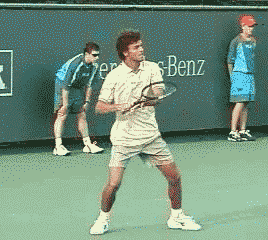|
TennisOne Lessons
Comparing Amateur and Modern Professional Forehands By Ray and Becky Brown We are often asked " what, in our opinion, is the greatest difference between amateur and professional stroke technique today?" Aside from the important differences related to conditioning, footwork, and other forms of training, one thing stands out: the ability to sustain high speed rallies with control and consistency. In this article, we explain two key factors that are essential to maintaining high speed, controlled, and consistent professional level rallies.
High ball speeds are achieved by producing high racquet head speeds. In this regard, amateurs and professionals differ significantly.To illustrate these differences, we have devised three videos in our studio modeled after amateur and professional forehands. Of course, since these illustrations are "staged", there are artificial aspects present. However, the essential differences in the technique are accurately portrayed. The single key difference is the interval over which the racquet head is rotated into the path of the ball. For the amateur, this interval generally starts the moment the racquet starts forward whereas for the professional, the rotation of the racquet head into the path of the ball is delayed until the latest possible moment. The video on the right illustrates the typical rotation event for the beginning or amateur forehand.
As shown in the video sequence, rotation begins as soon as the racquet starts forward from the takeback position. Below right is an example of the professional forehand sequence. In the professional sequence the racquet head is not rotated into the ball until the latest possible moment. This requires the elbow be brought forward in front of the body plane before it is accelerated into the path of the ball. For the amateur technique there arise two problems. First, using this method, it is very hard to produce high racquet head speeds without using the wrist. Second, when the rotation is initiated as the racquet is brought forward, the slightest wobble or unnecessary movement in the racquet head is quickly amplified usually leading to a miss-hit. Both problems make it very difficult to have control and consistency along with high ball speed. As mentioned above, in the professional forehand, the rotation of the racquet head into the path of the ball is delayed until just before the strike stage. This allows the professional to accelerate the racquet head to speeds twice that of the amateur while maintaining control and consistency.
In the video below we have superimposed a subset of the frames of the two preceding movies in order to provide a closer visual comparison of the two forehands. While the beginner's forehand is rotating from the start, the professional forehand is still contracting the butt of the racquet toward the ball. The obvious next question is this: Can anyone develop professional technique? The surprising answer is yes. Prior to the scientific use of photography to analyze tennis strokes, it would have been very difficult for the average player to develop professional technique. The reason for this is that the human eye just cannot see what is happening during the stroke. As a result, it was believed that one had to be born with "talent" (a metaphor for having a predisposition for the professional technique illustrated above). In fact, this was true since if you were not predisposed to hitting the way pros do, it would take several lifetimes of experimentation and lessons to have any hope of developing professional methods because it is too "unnatural". But scientific analysis has changed all of that and we are now entering a new era in which the average player will be able to develop strokes very close to professionals, and professionals will be able to develop "professional" strokes much earlier in their training than in the past. The result of these advancements is that tennis will regain much of the popularity it had in the 1970's because of the joy that average players will discover from being able to more closely emulate professional technique, and therefore better understand the modern game.
The only remaining question is: "how does one develop professional technique?" Clearly, the most important step is to develop the facility for bringing the racquet forward by the butt rather that rotating the racquet as it begins its forward movement. Next, one must get comfortable with having the elbow in front of the body plane when striking the ball (this takes about six weeks) and third, one must build up their strength to rapidly accelerate the racquet head into the path of the ball. If one works at developing these three skills about three times a week, you should see some improvements in about two weeks and greater improvements in about six weeks. Of course, the most important factor in developing these skills is believing that you can do it. We have seen significant improvements in players in as little as one week, so it has been done, and you can do it too. Your comments are welcome. Let us know what you think about Ray and Becky Brown's article by emailing us here at TennisONE. Ray and Becky Brown are the founders of EASI TennisTM. The EASI TennisTM System is a new and revolutionary method of teaching stroke technique that can dramatically reduce the time needed to learn to play master, or any level, of tennis. To learn more about the EASI TennisTM System, click here. |



